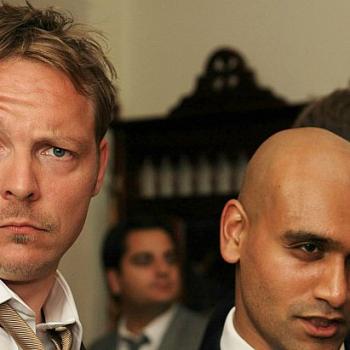Follow Mystic Post on Facebook
By Stephen Ryan
Incredible events are converging in this 100 year anniversary of both the Fatima prophecies and Russia’s “October revolution”. Are these events just ominous coincidences or does Catholic prophecy offer the best explanation  towards understanding today’s dangerous geopolitical environment?
towards understanding today’s dangerous geopolitical environment?
- Now with US missiles launched into Syria tensions between the United States and Russia are on high alert. Numerous elected officials have characterized Russia’s activities recently as “Acts of War”. USA media, particularly Rachal Maddow on MSNBC have engaged in unprecedented efforts to establish Russia as an untrustworthy enemy.
- Media around the world are asking “Has World War III started?
- Russia warns USA “You are this close to war.”
- Pope Francis speaks of the World being in a “Piecemeal World War III”
- One hundred years ago the Russian Revolution ushered in communist atheism and amazingly the uprising, also known as the “October revolution”, occurred almost on the exact date of Fatima’s “Miracle of the Sun”. This connection (coincidence?) deserves more awareness among the Catholic faithful. which took place on October 13, 1917. The “October revolution” would become known by the Vatican as “Russia’s error” thus confirming Fatima’s prophecy that Russia would play an active role in the attack against Christianity. Fatima’s prophecy also predicted that if Russia were consecrated to Our Lady’s heart, Russia would begin to return to God.
- In 1981 The Blessed Mother foretold of the benefits of Russia’s consecration by telling the six young Medjugorje visionaries that: “The Russian people will come to glorify God; the West has made modern progress but without God and act as if they are their own creators.” Medjugorje, it has been said is the “fulfillment of Fatima” and a strong argument can be made that this Medjugorje prophecy from the Queen of Peace is truly unfolding.
 Both Catholic prophecies – Fatima and Medjugorje – speak of Russia’s mysterious role in God’s plan and as geopolitical events unfold in this 100 anniversary of the Blessed Mother’s appearance at Fatima and the Russian Revolution, signs of the fulfillment of these prophecies seem to be surrounding humanity.
Both Catholic prophecies – Fatima and Medjugorje – speak of Russia’s mysterious role in God’s plan and as geopolitical events unfold in this 100 anniversary of the Blessed Mother’s appearance at Fatima and the Russian Revolution, signs of the fulfillment of these prophecies seem to be surrounding humanity.
To better understand the incredible accuracy of Catholic prophecy as it pertains to Russia, please take a look at the following article. The significance of the rise of Christianity – importantly a brand of Christianity that venerates the Blessed Mother – in Russia, cannot be overestimated and is the root cause of tensions between the West and Russia.
The rise of the Russian Orthodox Church
By Ivan Watson, Maria Stromova and Antonia Mortensen CNN
ST. PETERSBURG, Russia (CNN) — An unusual thing happened on a frigid winter’s day in Russia’s second-largest city.
More than 1,000 demonstrators wearing blue ribbons formed a human chain around St. Isaac’s Cathedral, one of St. Petersburg’s landmarks.
It was a peaceful and rare public protest under the watchful eyes of dozens of police officers.
Members of the crowd had one demand. They wanted to stop the enormous 19th-century cathedral from formally becoming a church.
“Museum! Museum!” protesters chanted for roughly 20 minutes before they quietly dispersed throughout the former imperial capital.
Secular demonstrators have staged several large protests in St. Petersburg in recent months in response to a government plan to take the cathedral away from the state museum that has managed St. Isaac’s as a historical monument for decades.
Under the proposal, the Russian Orthodox Church would assume direct control of the cathedral.
But as is often the case in Russia, this local dispute is symbolic of a much larger national debate.
“I’m worried about the role that the Russian Orthodox Church is trying to play in our lives,” said a protester named Galina Vozensenskaya.
“I’m fine with the church as long as it minds its own business,” added her husband, Vladimir Kudryavtsev, an academic from St. Petersburg.
“But when they overstep their boundaries on the question of abortion or middle school education or taking buildings like this, I’m not OK with it.”
March of the faithful
Hours before the protest, defenders of the Russian Orthodox Church staged their own peaceful show of force.
After conducting a long Sunday Mass beneath the soaring dome of St. Isaac’s Cathedral, bearded clerics dressed in long golden robes joined uniformed Cossacks in what Orthodox faithful call a “March of the Cross.”
Carrying icons, Orthodox banners and golden crosses on staves, they conducted a somber procession around the building while singing a Russian prayer.
Vitaly Milonov, a fiery, ultra-conservative lawmaker from the Russian national parliament, marched at the head of the procession.
“This is a very natural way to return those buildings that have been stolen from the church,” Milonov said.
He accused museum administrators of profiting from ticket sales charged to millions of tourists who visit the cathedral every year.
A spokesman for the Russian Orthodox Church in St. Petersburg argued that the reclamation of museum-churches such as St. Isaac’s would remove a vestige of the former Soviet Union.
“Some churches are still in the clutches of atheism,” Alexander Pelin told CNN.
“To leave them in the paradigm of the Soviet era is impossible.”
Anniversary of the Bolshevik Revolution
2017 marks a difficult anniversary for Russia.
A century ago, communist radicals swept to power in the Bolshevik Revolution. They set about destroying symbols of the imperial dynasty that had ruled Russia for centuries.
Among their many targets was the Russian Orthodox Church, long a pillar of legitimacy and support for the Romanov czars.
The fiercely atheist communists tore down one of the biggest churches in Moscow, the Cathedral of Christ the Savior, replacing it with a massive outdoor swimming pool.
They left St. Isaac’s standing.
It took 40 years for imperial Russia to construct the neoclassical basilica. The price tag, historians say, was greater than the amount the US government paid to purchase the Russian territory of Alaska in 1867.
The Soviets looted the building’s treasures and executed several of its top priests.
For years, they turned the cathedral — a former place of worship for the czars — into a museum against religion.
Alexander Kviatkovsky began working as a historian at St. Isaac’s in 1989, two years before the collapse of the Soviet Union.
One of his first tasks was to dismantle exhibits depicting the “anti-revolutionary activity” of Orthodox priests whom the Soviets had shot dead.
The same photos were later used in an exhibit to depict clerics who were martyred during the communist purges.
Today, Kviatkovsky is the deputy director of the Museum of St Isaac’s Cathedral.
He said the historical monument is a tourist attraction that welcomed more than 3.8 million visitors in 2016.
It also serves as a place of worship, where priests conducted 640 prayer services last year.
The historian concedes that relations with the clergy sometimes can be strained.
“We are constantly trying to find common ground and compromise,” Kviatkovsky says. “These 640 church services a year are part of that compromise.”
Orthodox renaissance
In the nearly 26 years since the Soviet Union’s collapse, the role of the once-persecuted Russian Orthodox Church has transformed dramatically.
The church has now become a defining characteristic of Russian identity actively promoted by the Kremlin.
“With the collapse of communist society, there was a great void,” said Alexander Dugin, chief editor of Tsargrad TV, a Russian Orthodox channel.
“The only way to fill this void was to return to the pre-communist values. And pre-communist values were Christian Orthodox.”
President Vladimir Putin, a former KGB agent of the atheist Soviet Union, now embraces his Orthodox Christianity. The Russian leader is often shown on national television broadcasts attending church services and paying respect to the church leadership.
The head of the Russian Orthodox Church, Patriarch Kirill of Moscow, is a respected member of the country’s elite.
In January, he gave a speech to lawmakers in the Duma — Russia’s national parliament– during which he called for a ban on abortion, denounced corruption and shared his opinion on temporal issues such as microfinance loans.
Several days later, dozens of bishops from across Russia and around the world gathered in the new Cathedral of Christ the Savior in Moscow. After the Soviet Union’s fall, the church was rebuilt on the same hilltop overlooking Moscow where the original cathedral once stood.
A representative from the Kremlin presented Kirill with a bouquet of flowers. Standing in the front row of the congregation were several young men from a Russian Orthodox activist group that calls itself the Forty Forties movement.
“Many say that this is the revival of the Russian Orthodox Church,” said Andrei Kormukhin, a leader of the group.
“We use a more colorful expression,” he added. “We are experiencing the second baptism of Russia.”
Orthodox Russians vs. amoral West
To many ultra-conservative supporters of the church, their faith distinguishes them from Western societies, which they accuse of becoming secular, impotent and amoral.
“This disease of anti-Christian activity will pass,” Milonov, the conservative lawmaker, told CNN after participating in a religious procession around St. Isaac’s Cathedral.
Speaking on the cathedral steps, the red-bearded Milonov used an English expletive to denounce former US President Barack Obama.
“Let fake values live together with Barack Obama, with his same-sex marriages, with his drugs, with his marijuana,” he said.
“Let him stay in his hell. We Russian and Americans are going forward. We are going to the true real values: family, church, state.”
Some Orthodox activists, such as Kormukhin of the Forty Forties movement, want the church’s status in Russia to be legally changed.
“We would be glad if the role that the Orthodox Church played in the foundation of the Russian state was reflected in the preamble of the constitution,” Kormukhin said.
The Forty Forties movement refers to the legend that there were 1,600 churches in Moscow before the 1917 revolution. The organization, which describes itself as a human rights group in defense of Orthodox Christians, lobbies for the construction of new churches across the Russian capital.
“If there were no Orthodox Christianity, there would be no Russia,” Kormukhin said.
Prosecution for insulting the church
Russia is officially governed by a secular constitution, which is applied to a society of multiple religions and ethnicities.
But over the past five years, the government has introduced laws and amendments to the criminal code that have cracked down on “insulting religious freedom.”
The most famous case involves the feminist punk provocateurs Pussy Riot, who served 22 months of a two-year prison sentence after they stormed into the Cathedral of Christ the Savior in 2012 to perform a song denouncing Putin.
This month, an atheist blogger was reportedly charged in court in Yekaterinburg with “insulting religious feelings” after posting a video of himself playing the mobile phone game “Pokémon Go” in a church.
The increasingly muscular protection of the church has drawn criticism from an outspoken member of the Russian Orthodox clergy.
“The church is being perceived as an enforcement agency … a ministry which has the right to arrest people. And this is very bad,” said Deacon Andrei Kuraev, who was a speechwriter for Patriarch Kirill’s predecessor.
Kuraev argues the current patriarch has gotten too cozy with the Kremlin.
“There’s an attempt by Patriarch Kirill to offer himself to the state and to the Kremlin as a faithful pillar, a faithful ally. There is an illusion in the Kremlin that they can use this ally to promote the correct electoral behavior,” Kuraev said.
“I am against this political union.”

















